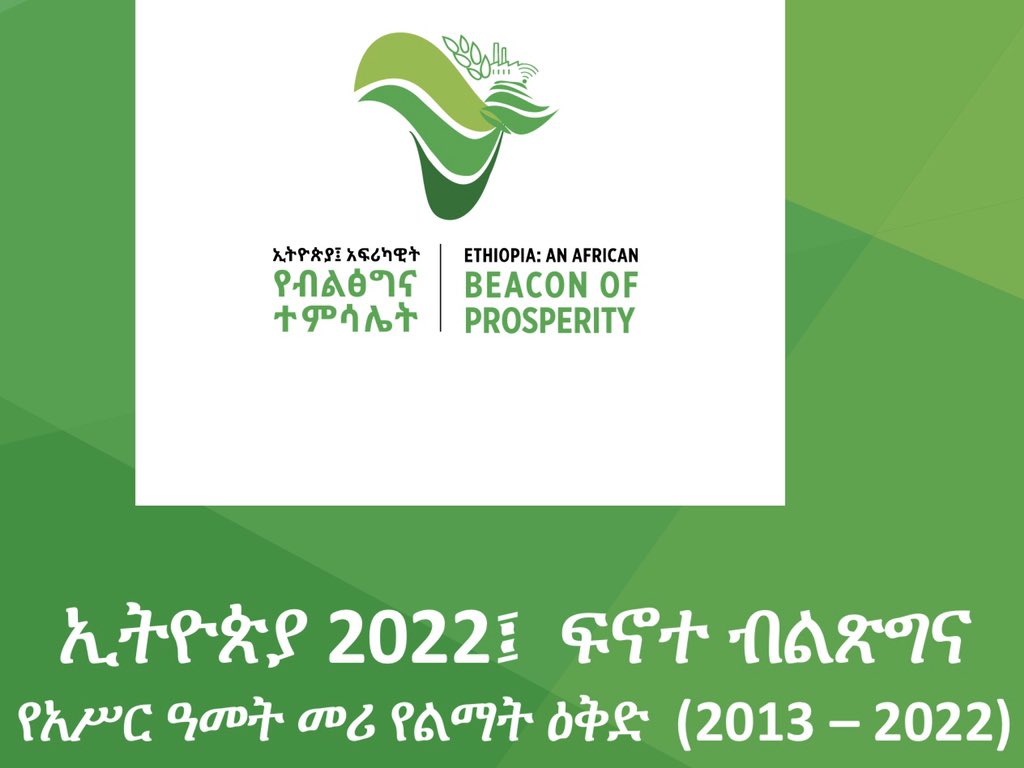
BY HIZKEL HAILU
Ethiopia is undertaking an all-round reform in the political, social and economic spheres. As part of this, the Plan and Development Commission has prepared a 10-year Economic Development Plan under the theme ‘Ethiopia: An African Beacon of Prosperity’ by 2030.
Ethiopia has registered strong social and economic development in recent years. While Ethiopia’s goal of achieving middle-income status by 2025 continues to shape policies, institutional arrangements and investment strategies, some macro level economic, environmental and political perspectives have shifted or been intensified, opening new areas for attention and action.
And it was also learnt that the House of People’s Representatives has also ratified the plan after different questions and answers were made between the members and the Prime Minister Abiy Ahmed on the House of Peoples’ Representatives 11th regular meeting.
Unlike the previous plans developed by the government, the current ten years perspective plan which was developed by the National Planning and Development Commission of Ethiopia is unique in its inclusiveness. And the plan is intended to ensure shared prosperity in all its dimensions, where every citizen gets access to it.
It has also been a while since the Commission started to gather inputs for the plan by organizing discussion forums with opposing parties, diplomats and stakeholders. It had also been gathering sectorial proposals to be included in the national economic plan.
Prime Minister Abiy Ahmed stated that the major aims of the new plan are ensuring economic growth which is private-sector-led, increasing production and competitiveness, building a green and climate-resilient economy and bringing about institutional transformation. It also envisions ensuring fair and equitable opportunities for women and youth across the country.
According to Fitsum Assefa (PhD), Planning and Development Commission Commissioner, the government has developed this perspective plan based on the demand of the country and the execution performance of previous plans, the nation’s vision for 2030, National Policies and Strategies, as well as the various International and Continental agreements.
The government was criticized for the fact that the previous development plan, which is the Growth and Transformation Plans (GTPs), lacked adequate monitoring and follow-up mechanisms during its implementation. Several megaprojects, including the Grand Ethiopian Renaissance Dam (GERD), experienced delays which in turn forced the country to incur an additional cost.
Cognizant of this fact, the commission has also prepared a system for effective monitoring and follow up mechanism to oversee the implementation of the current plan.
As to her, the recently ratified plan requires a result-oriented monitoring and evaluation system for better achievement. It is different from the previous national plans as it is believed to bring about visible changes in the living standards of citizens.
Fitsum further vowed that the prospective plan which aims to make Ethiopia competent and resilient is prepared in a way to make it easier for any party that wins the coming elections and holds office to adopt and implement it.
“The plan is prepared by taking the specific contexts and interests of the country rather than the interests of a single party. That is why various discussions have been held with different stakeholders including politicians to clear confusions and create consensus on the document,” she said. The plan has also been ratified by the council of ministers after detailed discussion.
Recalling that ensuring sustainable growth and development is among the pillars, she stated that it aims at uplifting financial sector accessibility in rural areas to embolden the public’s saving culture and encouraging enterprises and corporations to invest in the manufacturing sector.
Moreover, another pillar of the economic plan is its vision to make the private sector take the leading role in the economy. This pillar comprises designing and applying the private sector development strategy to make sure that the private sector takes a leading role and domestic investors play a critical role in the process.
The commission has developed an automated reporting system for every public institution from the ministerial to district levels in order to avoid data discrepancy; she said adding that “the commission has also prepared a strong monitoring and evaluation guideline.”
Finance Minister Ahmed Shide on his part stressed the need for the participation of political parties in the process of developing the plan before its ratification. And he said that all Ethiopians are concerned about the Ethiopian issue.
The 10 year perspective plan envisages Ethiopia to become a lower middle income country by 2025; reduce the population below the poverty line to 7% and unemployment to less than 9%. However, these targets have been lowered considering the impact of Covid-19 and other internal and external factors.
Appreciating the exclusiveness of the 10 years perspective plan of the reformist government led by Laureate Abiy Ahimed, Finance and Economy Expert Hailemeskel Gazu told to The Ethiopian Herald that the plan can be achievable if the current government can strive enthusiastically for its implementation.
Since 1940, the former Ethiopians leaders including Emperor Haileselsea, President Mengistu Hailemariam as well as the then EPDRF have planned different short, middle and long term plans that were aimed to transfer Ethiopia from Agricultural to Industry led economy. Nonetheless, Hailemeskel explained that none of them could not achieve what they aspired to.
As part of the reform, this plan is differ from the previous ones due to its inclusiveness of the opposing parties and other stakeholders coupled with its compatibility with the current status of the citizen and the capacity of the government as well. But the government should give due emphasis for monitoring and evaluating each and every activity of the actors in every sector, he added.
As to him, the government should work exhaustively in the area of revenue collection in particular and fiscal policy in general. Because the government is not collecting the amount of money that it should collect from the taxpayers due to the hassle and complicated corruption chain parallel with the limitation of execution capacity of the public sectors.
In this regard he also appreciated the National Planning and Development commission for its commitment to prepare and develop an automated reporting system for every public institution from the ministerial to district levels in order to avoid data discrepancy.
He also mentioned that the performing capacity of both the public and private sectors were increasing in high rate following the reform within the past three years due to the motivation of the reformist leader Abiy Ahimed. Adding to the point he elucidated that the current circumstance which is lack of peace and stability in some parts of the country will hinder the successful implementation of the prospective plan.
Surprisingly and remarkably the perspective plan was revised several times during the course of 20 rounds of consultative workshops. And recalling Commissioner Fitsum’s idea that some 3,000 questions and comments have been forwarded to the commission and it has identified absolute and comparative economic advantages across the country, Hailemeskel explained his hope about the achievability of the plan.
All things considered the expert and officials agreed that the plan needed excessive monitoring and evaluation mechanisms for its successful implementation. Therefore taking the reform as a huge opportunity, every stakeholders in the sector should work in harmony for its implementation, the commissioner loads.
The Ethiopian Herald April 2/2021




